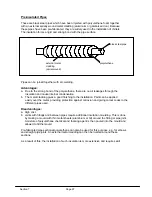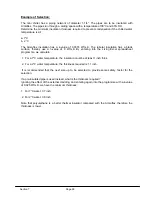
Sectional Polyurethane
As an alternative to the pre-insulated pipes, pre-fabricated sectional polyurethane can be
attached onto the bare black steel pipes with an external metal cladding rivetted around the pipe.
Various shapes and sizes are available to fit the piping network.
It is important that a layer of grease to be applied on the internal surface of the polyurethane
sections before placing it around the pipe. These sections are then secured tightly around the
pipe by tying with metal wire.
The layer of grease is to ensure that the sections stick firmly onto the pipe surface and to seal
any air gaps, especially at sections' joining surfaces, thus preventing condensation.
Even though this method is cheaper compared with the preinsulated pipe, one major problem is
condensation because it is difficult to ensure a complete air-tight installation along the entire pipe
length due to the number of sections used.
Closed Cell Elastomeric Insulation
This type of insulation, made from nitrile rubber, is usually used with copper pipes. Some common
names for this type of insulation are Armaflex, Insuflex and Superlon. Tubular form of this
insulation are usually used for the copper pipes. However, sheet form are also used to insulate
storage tanks, ductwork and steel pipes.
This insulation is soft, flexible and easy to install. It can be formed to suit various shapes and
sizes.
For the tubular form, the insulation can either be slipped-on or snapped-on. Adhesive is then used
to stick together all the joining surfaces. It is not needed to stick the insulation onto the pipe itself.
Rather, the correct size of the insulation must be used to match the pipe external diameter. Using
too large a size will cause air pockets in between the insulation and pipe which will create
condensation. A smaller size will not allow the pipe to slip-on or cause incomplete wrap-around
during snap-on. See Appendix 13.
For the sheet form, adhesive can be used to just stick the insulation onto the surface.
Joining edges and corners can also be sticked in the same manner.
This type of insulation is of the closed cell structure. As compared with the open cell insulation,
the closed cell give better thermal insulation performance and lower water moisture permeability.
Absorption of water into the insulation will cause degradation of the thermal conductivity
properties over time. Hence, it is not desired for the insulation to retain water.
Section 7
Page 98
Summary of Contents for AC 40A
Page 1: ...AM MAC ...
Page 153: ...Appendix 1 ...
Page 154: ...Appendix 2 Appendix 2 ...
Page 157: ...GRAPH OF PRESSURE DROP VS FLOW FOR VARIOUS C V RATINGS Appendix 5 1 ...
Page 158: ......
Page 159: ...Water Capacity Graph Appendix 5 2 ...
Page 160: ...CHART 3 FRICTION LOSS FOR CLOSED PIPING SYSTEMS Appendix 6 1 ...
Page 161: ...CHART 4 FRICTION LOSS FOR OPEN PIPING SYSTEMS Appendix 6 2 ...
Page 162: ...CHART 5 FRICTION LOSS FOR CLOSED AND OPEN PIPING SYSTEMS Appendix 6 3 ...
Page 168: ...Appendix 8 Appendix 8 ...
Page 169: ...Appendix 8 1 ...
Page 170: ...Appendix 8 2 ...
Page 171: ...Appendix 8 3 ...
Page 172: ...Appendix 8 4 ...
Page 173: ...Appendix 8 5 Appendix 8 5 ...
Page 174: ...Appendix 8 6 Appendix 8 6 ...
Page 175: ...Appendix 8 7 Appendix 8 7 ...
Page 176: ...Appendix 9 ...
Page 178: ...Appendix 11 1 Appendix 11 1 ...
Page 179: ...Appendix 11 2 Appendix 11 2 ...
Page 180: ...Appendix 13 ...
Page 181: ...Appendix 13 1 ...
Page 182: ...Appendix 14 Appendix 14 ...
Page 183: ...Appendix 15 1 Appendix 15 1 ...
Page 186: ...Appendix 17 Appendix 17 ...
Page 187: ...Appendix 18 ...
Page 188: ...CE20DW CE25DW Note PRESSURE DROP CORRECTION FACTOR 1 2947 0 0021 EWTºF Appendix 19 ...
Page 189: ... 2003 McQuay International 603 55194922 www mcquayup com ISO 9002 REGISTERED ...
















































